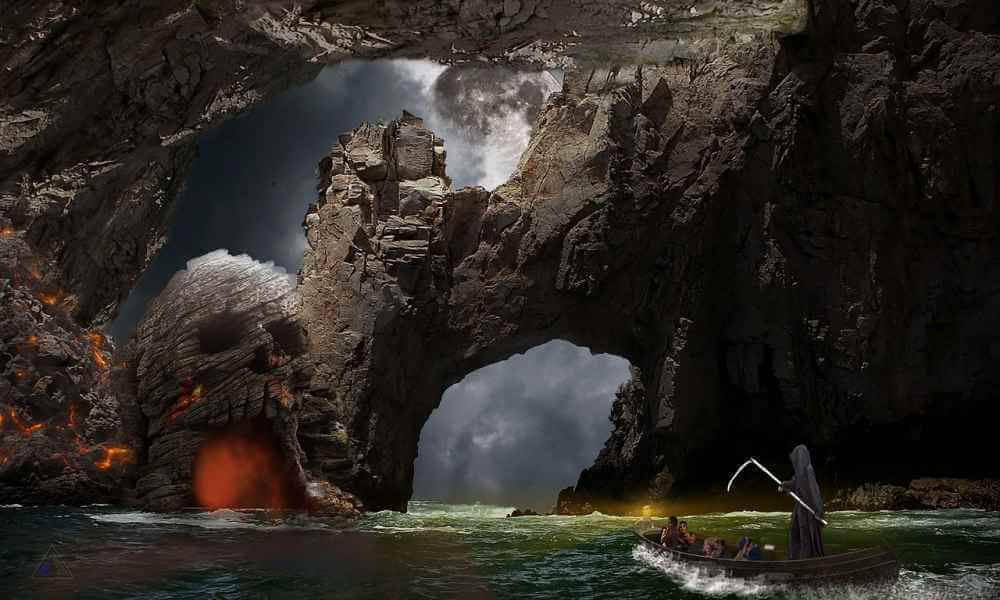Cave Paintings: In ancient workmanship, the expression “give in painting” envelops any parietal craftsmanship which includes the utilization of shading colors on the dividers, floors or roofs of old shake covers. A monochrome give in painting is a photo made with just single shading (generally dark) – see, for example, the monochrome pictures at Chauvet.

A polychrome give in painting comprises of at least two hues, as exemplified by the superb multi-hued pictures of buffalo on the roof at Altamira, or the heavenly aurochs in the Chamber of the Bulls at Lascaux. Interestingly, the expression “give in drawing” alludes (entirely) just to an engraved drawing – that is, one made by cutting lines in the stone surface with a rock or stone device, instead of one made by drawing lines with charcoal or manganese.
Origins and History of Cave Paintings
At present we have no firm thought when surrender painting initially started. One hypothesis connects the advancement of Stone Age workmanship to the entry of anatomically current people in Europe amid the time of the Upper Paleolithic.
As indicated by this hypothesis, the improvement of surrender craftsmanship harmonized with the removal of Neanderthal man by anatomically present day man, beginning around 40,000 BCE. Without a doubt, it was from about this date the most punctual shake workmanship started to rise in hollows and shake protects far and wide, however particularly all through the Franco-Cantabrian district.
Painting starts things out, trailed by mobiliary workmanship, as exemplified by the compact Venus dolls like the Venus of HohleFels (3833,000 BCE). Extensively, give in painting procedures and materials enhanced in all cases, step by step. Along these lines we see the monochrome compositions of Aurignacian culture (40-25,000 BCE) offer route to the polychrome specialty of the Gravettian (25-20,000 BCE), prompting the apogee of give in painting which is customarily recognized to happen amid the Magdalenian period (c.15-10,000 BCE) at Lascaux, Altamira, Font de Gaume and Les Combarelles.
Amid the Late Magdalenian, the Ice Age finished and a time of a dangerous atmospheric devation prompted the pulverization of the Magdalenian reindeer territory, alongside its way of life and its give in workmanship. For additional about the advancement of give in painting, and how it fits into Stone Age culture, sees: Prehistoric Art Timeline (from 2.5 million BCE).
Types of Cave Paintings
The greater part of ancient surrender works of art were metaphorical and 99 percent of these were of creatures. At to begin with, Stone Age specialists painted predator creatures (lions, rhinoceroses, saber-toothed cats, bears) nearly as frequently as amusement creatures like buffalo and reindeer, yet from the Solutrean time onwards symbolism was commanded by diversion creatures.
Pictures of people were a particularly uncommon event, and were generally very adapted and far less naturalistic than the creature figures. Unique symbolism (signs, images and other geometric markings) was additionally normal, and really involves the most seasoned kind of Paleolithic craftsmanship found in holes of the Late Stone Age, as appeared by late dating outcomes on artistic creations at El Castillo and Altamira.
Notwithstanding figure painting and theoretical symbolism, ancient holes are likewise vigorously designed with painted hand stencils shake craftsmanship, the majority of which – as indicated by late research by Dean Snow of Pennsylvania State University – were made by females, yet men and kids were additionally included. A portion of the best cases of this type of painting are the Gargas Cave Hand Stencils (Haute-Garonne), the Panel of Hand Stencils at Chauvet (Ardeche), and the prints all through the Cueva de las Manos (Cave of the Hands) in Argentina.
Cave Painting in Three Stages
Ordinarily a polychrome surrender painting was made in three fundamental stages, which may change essentially as per the experience and social development of the craftsman, the nature and shapes of the stone surface, the quality and kind of light, and the crude materials accessible.
Take a photo of a buffalo, for example. In the first place, the diagram and fundamental elements of the creature are drawn on the give in divider, either by scoring the surface of the stone with a honed stone, or by applying a dark blueprint utilizing charcoal or manganese. Second, the finished drawing of the creature would be hued or filled in with red ochre or different colors.
Third, the edges of the creature’s body would be shaded with dark or another color to expand its threedimensionality. On the other hand, contingent upon regardless of whether the shape of the give in divider made it essential, extra etching or notwithstanding chiseling would be connected to lift volume and alleviation.
Famous Caves Containing Stone Age Paintings
1. Europe
Franco-Cantabrian ancient surrender painting is presumably more popular than whatever other convention of parietal workmanship around the globe. Here are the district’s most acclaimed improved hollows.
Give in of El Castillo (39,000 BCE) Puente Viesgo, Spain Discovered in the complex of the Caves of Monte Castillo, this stone haven contains the most established craft of any collapse Europe, aside from the La Ferrassie Cave Cupules (c.60,000 BCE), Fumane Cave (c.35,000 BCE) Italian ancient give in possessed by Aurignacian reindeer seekers, in which various primitive creature give in artistic creations were found on sections of a broken down give in divider, Abri Castanet (c.35,000 BCE) Dordogne shake protect containing engraved pictures of female genitalia and male phalluses, alongside ochre works of art of steeds and some unique images, Altamira Cave (first stage 34,000 BCE) Antillana del Mar, Spain A club-molded image found in the most remote piece of the give in was U/Th dated to 34,000 BCE, Chauvet Cave (c.30,000 BCE) Vallon-Pont-d’Arc, FranceFound in 1994, Chauvet surrender – a grandstand of Aurignacian Art – contains two principle parts.

In the main, most pictures are red, while in the second, the creatures are for the most part dark. The most striking pictures are the Horse Panel and the Panel of Lions and Rhinoceroses. See Chauvet Cave Paintings, Grotte des Deux-Ouvertures (Cave of Two Openings) (c.28,000-26,000 BCE) Ardeche Gorge, close ChauvetCaveNoted for its stone etchings of creatures including more than 50 figures of bulls and mammoths.
2. India
The Auditorium and Daraki-Chattan Caves in Madhya Pradesh, Central India, have as of late been found to contain the world’s most established known cupule workmanship, as container like spaces (petroglyphs) etched on hard quartzite, going once more into the Lower Paleolithic period. For points of interest and photographs, see: Bhimbetka Petroglyphs and Daraki-Chattan Cave Art.Another imperative site of Stone Age workmanship in India is the Bhimbetka Rock Shelters, an UN World Heritage Site which was referred to Indian archeologists as ahead of schedule as 1888. Situated in the region of Madhya Pradesh south of Bhopal at the edge of the Vindhyachal slopes, this site contains the most punctual hints of human life in India, in spite of the fact that its stone craftsmanship is just around 9,000 years of age.
Highlighting a large group of various scenes (eg. chasing, moving, horse riding, elephant riders, creature battles, residential scenes and so forth), and subjects (eg. buffaloes, tigers, lions, wild hog, elephants, impalas pooches, reptiles, crocodiles), all generally painted in red and white, with periodic utilization of green and yellow, the photos traverse the majority of the Mesolithic and Neolithic times of the Stone Age, and in addition the Bronze, Iron and later Medieval ages.
3. South Africa
African craftsmanship incorporates a portion of the world’s most old workmanship, including whole artworks. The most established African shake craftsmanship was found in the Blombos Caves, not a long way from Capetown. It includes various geometric inscriptions on two little bits of ochre hued stone, and dates from 70,000 BCE. For points of interest and photographs, please observe: Blombos Cave Art.
4. Namibia
A progression of geometric and creature pictures engraved and painted on seven stone chunks have been found at the Apollo 11 Caves in the Huns Mountains, dating to 25,500 BCE. (For subtle elements, see: Apollo 11 Cave Stones.) Unusually, the pictures – painted in charcoal, red ochre and white – were painted onto the pieces at an alternate area and afterward conveyed to the give in. Specialists think of them as an early model of Tribal workmanship.
4. Australia
Australian natives were in charge of the entire mainland’s paleolithic craftsmanship. The most established customs of
Aboriginal craftsmanship – accepted to date from 30,000 BCE, in spite of the fact that this is unverified – incorporate Kimberley shake workmanship (Western Australia), Ubirr shake craftsmanship, Arnhem Land, Northern Territory, and Burrup Peninsula shake workmanship (Pilbara). Later works incorporate the Bradshaw depictions (now called Gwion workmanship), dating from 15,500 BCE, at Kimberley, Western Australia. Be that as it may, the most seasoned craftsmanship in Australia is the NawarlaGabarnmang Rock Shelter charcoal drawing, which was cell based dated to 26,000 BCE.
5. Argentina
The Cueva de las Manos (Cave of the Hands) at Rio de las Pinturas is home to the most established surrender painting in the Americas. The most seasoned paintings, dating from the time of Mesolithic workmanship, around 9,000 BCE, contain many hand stencils painted in red, high contrast shades. Later pictures incorporate works of art of creatures, chasing scenes and complex conceptual examples (ideomorphs).

Investigations of their buckle craftsmanship, designs and improved bones, stones and shakes by archeologists, and different researchers, have uncovered a workmanship that created from oversimplified early structures to definite, exact figures more than a few sequential periods. The specialists started by drawing basic diagrams of little creatures. Afterward, they drew bigger creatures and filled in the creatures’ bodies with red or dark paint; lastly, they drew huge creatures, washed over the creatures’ bodies with gritty tones of darker or dark, and itemized the creatures’ life structures with thick shading.
6. Southeast-Asia
Shake canvases have likewise been found in Thailand (in the Petchabun Range of Central Thailand, and in NakornSawan Province), Malaysia (at GuaTambun in Perak, and in the Painted Cave at Niah Caves National Park) and Indonesia, in the Sangkulirang territory of Kalimantan. Late finds in the Maros-Pangkep gives in on the Indonesian island of Sulawesi, demonstrate that a portion of the most seasoned craftsmanship on the planet was made by transients island-bouncing towards Australia.
These finds recommend that cutting edge man’s imaginative capacity did not rise “fortuitously” over the world, but rather was produced before he cleared out Africa, around 80,000 BCE. See additionally: Oceanic workmanship.




